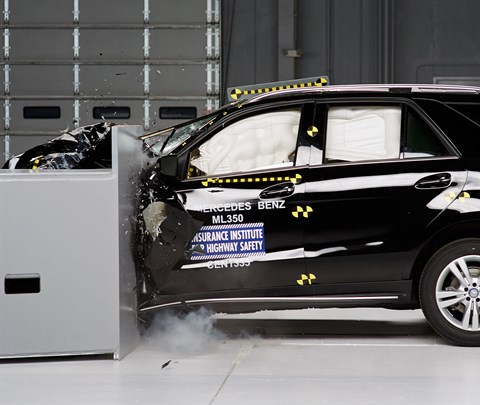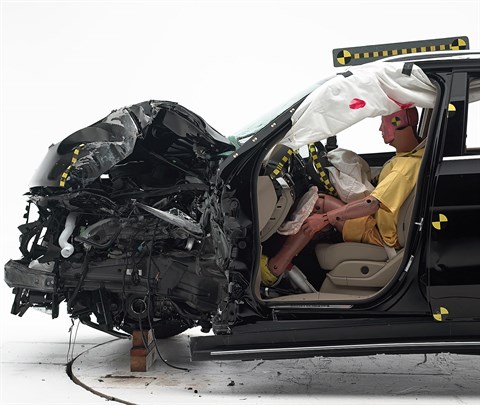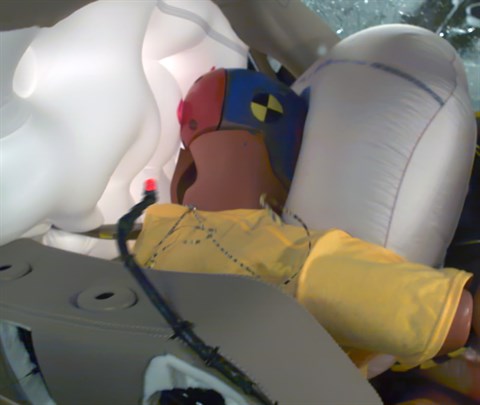Small overlap front: driver-side
Rating applies to 2016-19 models
Tested vehicle: 2014 Mercedes-Benz ML 350 4-door 4wd
The Mercedes-Benz M-Class was redesigned for the 2012 model year and renamed the GLE-Class beginning with the 2016 model year.
Beginning with 2014 models built after August 2013, reinforcements were added to the door sills to improve occupant protection in small overlap frontal crashes. (Information about when a specific vehicle was manufactured is on the certification label typically affixed to the car on the driver door or adjacent B-pillar.) The tested 2014 model M-Class was built after the door sills were strengthened.
| Evaluation criteria | Rating |
|---|---|
| Structure and safety cage | |
| Driver injury measures | |
| Head/neck | |
| Chest | |
| Hip/thigh | |
| Lower leg/foot | |
| Driver restraints and dummy kinematics | |

Action shot taken during the driver-side small overlap frontal crash test.

The dummy's position in relation to the door frame, steering wheel, and instrument panel after the crash test indicates that the driver's survival space was maintained reasonably well.

The frontal and side curtain airbags worked well together to keep the head from coming close to any stiff structure or outside objects that could cause injury.

Intrusion of the footrest and instrument panel was sufficient to contribute to a moderate risk of injury to the left lower leg, even though the knee airbag inflated.
Small overlap front: passenger-side
Rating applies to 2016-19 models
Tested vehicle: 2018 Mercedes-Benz GLE 350 4-door 4wd
The Mercedes-Benz M-Class was redesigned for the 2012 model year and renamed the GLE-Class beginning with the 2016 model year.
Beginning with 2014 models built after August 2013, reinforcements were added to the door sills to improve occupant protection in small overlap frontal crashes. (Information about when a specific vehicle was manufactured is on the certification label typically affixed to the car on the driver door or adjacent B-pillar.)
Passenger-side small overlap frontal ratings are assigned by the Institute based on a test conducted on a 2018 model GLE-Class by Mercedes-Benz.
| Evaluation criteria | Rating |
|---|---|
| Overall evaluation | |
| Structure and safety cage | |
| Passenger injury measures | |
| Head/neck | |
| Chest | |
| Hip/thigh | |
| Lower leg/foot | |
| Passenger restraints and dummy kinematics | |
| Driver injury measures | |
| Head/neck | |
| Chest | |
| Hip/thigh | |
| Lower leg/foot | |
| Driver restraints and dummy kinematics | |
Moderate overlap front: original test
Rating applies to 2016-19 models
Tested vehicle: 2012 Mercedes-Benz ML 550 4-door 4wd
The Mercedes-Benz M-Class was redesigned for the 2012 model year and renamed the GLE-Class beginning with the 2016 model year. Moderate overlap frontal ratings are assigned by the Institute based on a test conducted on a 2012 model M-Class by Mercedes-Benz.
| Evaluation criteria | Rating |
|---|---|
| Overall evaluation | |
| Structure and safety cage | |
| Driver injury measures | |
| Head/neck | |
| Chest | |
| Leg/foot, left | |
| Leg/foot, right | |
| Driver restraints and dummy kinematics | |
Side: original test
Rating applies to 2016-19 models
Tested vehicle: 2014 Mercedes-Benz ML 350 Bluetec 4-door 4wd with standard front and rear head curtain airbags and standard front seat-mounted torso airbags
The Mercedes-Benz M-Class was redesigned for the 2012 model year and renamed the GLE-Class beginning with 2016 models.
Beginning with 2014 models, side torso airbags became optional for rear seat occupants (they were standard in 2012-13 models). Side ratings are assigned by the Institute based on two tests conducted by Mercedes-Benz.
The first test was conducted on a 2012 model ML 550 V8 (including the standard rear side torso airbags) and the second test on a 2014 model ML 350 Bluetec diesel V6 without the optional rear side torso airbags. The ratings for these vehicles are combined because the presence or lack of rear side torso airbags made little difference for rear occupant protection in the tests. (Rear occupants still receive the benefit of the standard side curtain airbags.) This is because for a large vehicle with a long wheelbase (115 inches in this case), the intruding barrier impacts the vehicle relatively far from the rear seat.
| Evaluation criteria | Rating |
|---|---|
| Overall evaluation | |
| Structure and safety cage | |
| Driver injury measures | |
| Head/neck | |
| Torso | |
| Pelvis/leg | |
| Driver head protection | |
| Rear passenger injury measures | |
| Head/neck | |
| Torso | |
| Pelvis/leg | |
| Rear passenger head protection | |
Roof strength
Rating applies to 2016-19 models
Tested vehicle: 2012 Mercedes-Benz ML 350 4-door 4wd
| Overall evaluation | |
|---|---|
| Curb weight | 4,722 lbs |
| Peak force | 31,545 lbs |
| Strength-to-weight ratio | 6.68 |
Head restraints & seats
Seat type: Power leather seat AHR
| Overall evaluation | |
|---|---|
| Dynamic rating | |
| Seat/head restraint geometry |
About the head restraint & seat test
Currently, IIHS tests apply only to front seats.
Headlights
Ratings are given for 4 different headlight variations available on this vehicle.
Trim level(s)
- GLE 350 trim equipped with Premium 2 package; built after March 2018
- GLE 350 trim equipped with Premium 3 package; built after March 2018
| Evaluation criteria | Rating |
|---|---|
| Low-beam headlight type | LED projector |
| High-beam headlight type | LED projector |
| Curve-adaptive? | Yes |
| High-beam assist? | Yes |
|
Overall rating | |
| Distance at which headlights provide at least 5 lux illumination: | |
Low beams
On the straightaway, visibility was good on the right side of the road and fair on the left side. On curves, visibility was good on both right curves and fair on both left curves.
The low beams created some glare.
High beams
On the straightaway, visibility was good on both sides of the road. On curves, visibility was good in all 4 tests.
High-beam assist compensates for some limitations of this vehicle's low beams on the straightaway and on both left curves.
Trim level(s)
- GLE 350 trim
| Evaluation criteria | Rating |
|---|---|
| Low-beam headlight type | Halogen projector |
| High-beam headlight type | Halogen reflector |
| Curve-adaptive? | No |
| High-beam assist? | No |
|
Overall rating | |
| Distance at which headlights provide at least 5 lux illumination: | |
Low beams
On the straightaway, visibility was inadequate on both sides of the road. On curves, visibility was inadequate in all 4 tests.
The low beams never exceeded glare limits.
High beams
On the straightaway, visibility was good on the right side of the road and inadequate on the left side. On curves, visibility was inadequate in all 4 tests.
Trim level(s)
- GLE 350 trim equipped with Premium II package; built before December 2017
- GLE 350 trim equipped with Premium III package; built before December 2017
| Evaluation criteria | Rating |
|---|---|
| Low-beam headlight type | LED projector |
| High-beam headlight type | LED projector |
| Curve-adaptive? | Yes |
| High-beam assist? | Yes |
|
Overall rating | |
| Distance at which headlights provide at least 5 lux illumination: | |
Low beams
On the straightaway, visibility was good on the right side of the road and fair on the left side. On curves, visibility was fair on the sharp left and both right curves and inadequate on the gradual left curve.
The low beams created some glare.
High beams
On the straightaway, visibility was good on the right side of the road and inadequate on the left side. On curves, visibility was fair on the gradual right curve and inadequate on the sharp right and both left curves.
High-beam assist compensates for some limitations of this vehicle's low beams on the straightaway, on both left curves and on both right curves.
Trim level(s)
- GLE 350 trim equipped with Premium II package; built after November 2017 and before April 2018
- GLE 350 trim equipped with Premium III package; built after November 2017 and before April 2018
| Evaluation criteria | Rating |
|---|---|
| Low-beam headlight type | LED projector |
| High-beam headlight type | LED projector |
| Curve-adaptive? | Yes |
| High-beam assist? | Yes |
|
Overall rating | |
| Distance at which headlights provide at least 5 lux illumination: | |
Low beams
On the straightaway, visibility was good on both sides of the road. On curves, visibility was good on the sharp left and gradual right curves and fair on the sharp right and gradual left curves.
The low beams created some glare.
High beams
On the straightaway, visibility was good on the right side of the road and inadequate on the left side. On curves, visibility was fair in all 4 tests.
High-beam assist compensates for some limitations of this vehicle's low beams on the straightaway, on both left curves and on both right curves.
Front crash prevention: vehicle-to-vehicle
Ratings are given for 2 different trim variations available on this vehicle.
Child seat anchors
Rating applies to 2016-19 models
| Evaluation criteria | Rating |
|---|---|
| Overall evaluation | |
| Vehicle trim | GLE 350 |
| Seat type | leather |
This vehicle has 2 rear seating positions with complete child seat attachment (LATCH) hardware.
It has 1 additional seating position with a tether anchor only.
| Evaluation criteria | Rating |
|---|---|
| Overall evaluation | |
| Vehicle trim | GLE 350 |
| Seat type | leather |
| Rating icon | Rating |
|---|---|
| G | Good |
| A | Acceptable |
| M | Marginal |
| P | Poor |
| Seating positions that rely on borrowed lower anchors or have only a tether anchor available are not rated. | |
thether anchor symbol | Tether anchor |
lower anchor symbol | Lower anchors |
| Lower anchor(s) can be borrowed from adjacent positions(s) | |
| No hardware available |
Details by seating position
| Position | Rating |
|---|---|
| 1 | |
| Tether anchor | |
| easy-to-find location | |
| no other hardware could be confused for anchor | |
| Lower anchors | |
| not too deep in seat | |
| not too much force needed to attach | |
| easy to maneuver around anchors | |
| 2 | |
| Tether anchor | |
| easy-to-find location | |
| no other hardware could be confused for anchor | |
| Lower anchors | |
| none available | |
| 3 | |
| Tether anchor | |
| easy-to-find location | |
| no other hardware could be confused for anchor | |
| Lower anchors | |
| not too deep in seat | |
| not too much force needed to attach | |
| easy to maneuver around anchors |
